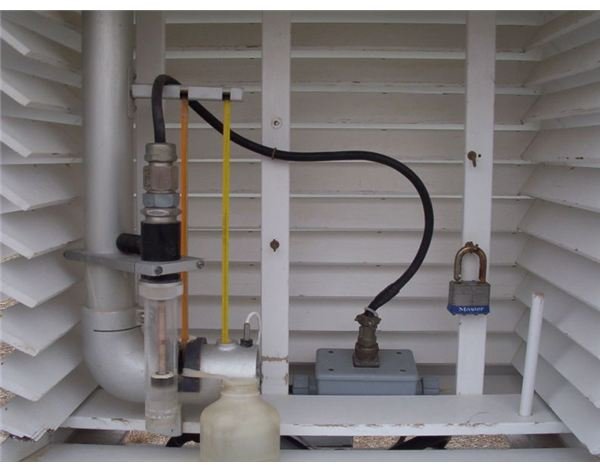Types of Weather Instruments
Introduction to Weather Instruments: Types
Most of the weather instruments used by meteorologists have been around for some time being well tried and tested for over a century. Nevertheless, these instruments are still accurate due to being upgraded to digital and electronic versions that provide a print out or transmit the data to the meteorologists.
Here we discuss some different types of weather instruments used to collect data for weather forecasting. We shall concentrate on the ones normally housed in a Stevenson Screen Structure or their own similar container and located at a typical weather station.
Types of Weather Instruments
Although the following types of instruments are used at meteorological stations for collecting data for weather forecasting, some of them can also be used to record weather properties of the higher atmosphere from a weather balloon. Please click on images to enlarge.
Instruments can have their own containers or be housed in a Stevenson Screen Structure that is slatted or louvered to allow air circulation. It is painted white to reflect heat and is situated facing north to avoid direct sunlight. It is placed three to six feet (one to tow meters) above the ground as this is the standard height for surface temperature observations. A Stevenson Screen is shown below:
1. Barometer
This is used to measure atmospheric pressure. There are several types;
- Aneroid Barometer - this is a dry barometer that operates on a partially evacuated corrugated bellows (tube), supported by a spring. As the atmospheric pressure rises and falls, the corrugated bellows and the spring to expand and contract. The spring is attached by a lever to a calibrated dial that indicates the atmospheric pressure. An Aneroid barometer is shown below;
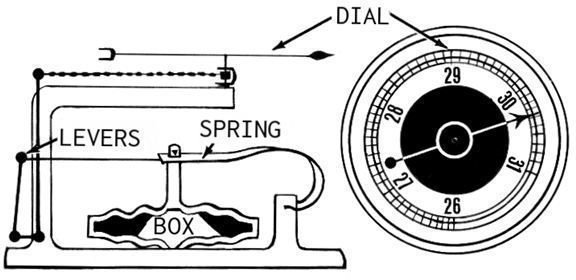
- Mercury Barometer – this uses a calibrated vertical glass tube, enclosed at the top. The bottom of the tube is open and placed in a dish of mercury. As the atmospheric rises and falls, the level of mercury in the glass acts accordingly and the pressure is read of the glass calibration.
- Barograph – this works on the principle of an aneroid barometer only the variations in atmospheric pressure are recorded on a chart attached to a revolving drum.
2. Thermometers.
These consist of enclosed tubes with a reservoir “bulb” at the bottom. They are attached to a wood or plastic support that is calibrated to read in ᴼC and ᴼF. There are several categories;
- Mercury – this is used to record high temperatures
- Alcohol – used to record lower temperatures as alcohol has a low freezing point.
- Electrical Max/Min Temperature Sensor (MMTS)
MMTS is the more modern method used to record the maximum and minimum air temperatures electronically, and transmitting them to the weather station. It is located in a container similar to the Stevenson Screen Structure.
An alcohol thermometer is shown below;
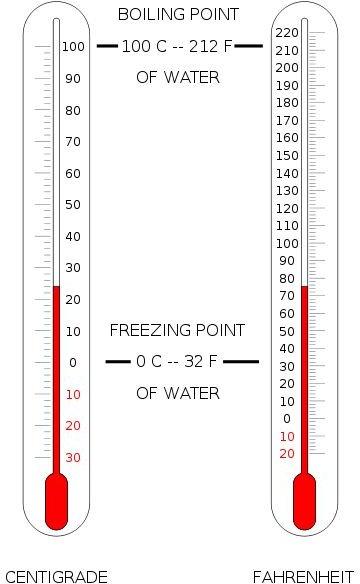
3. Psychrometer
This is an instrument used to measure humidity (the amount of water vapor in the atmosphere). A humidity reading is achieved by using temperature readings from a wet bulb and a dry bulb thermometer. The dry bulb thermometer is a mercury one the wet one being identical except a wet cloth is wrapped around the bulb. Using tables or dividing one temperature into the other gives the percent of humidity.
A psychrometer is shown below;
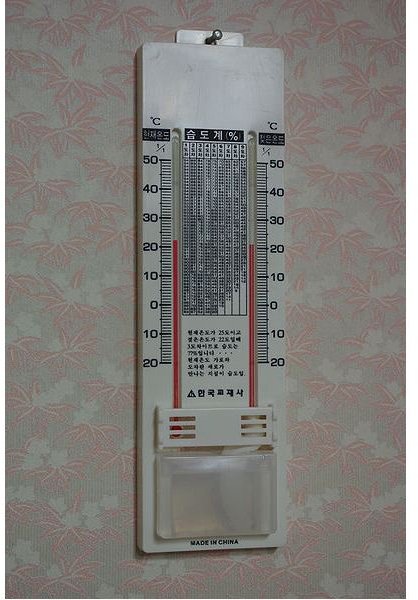
4. Anemometer.
The anemometer is used measure wind speed and direction. It is mounted on a mast of standard height of 30 feet (10 meters), and there should be no obstructions such as buildings or trees to deflect the wind from the anemometer. It should also be set absolutely vertical and to true north for an accurate wind direction indication. There are several types of anemometers;
- Cup Anemometer.
This is the type most of us are familiar with. Modern ones have three cups and a vane at the tail to give wind speed and direction. A modern cup anemometer is shown below;
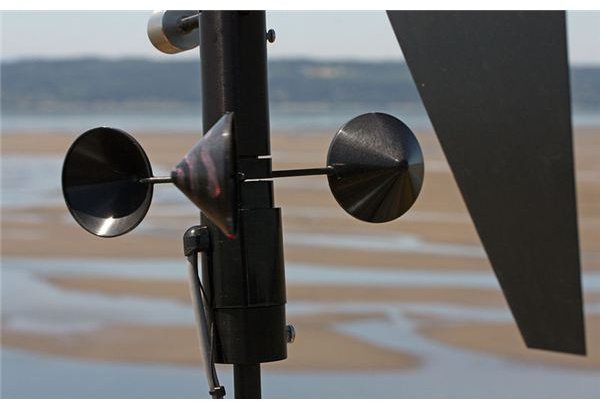
- Ultrasonic Anemometer.
This instrument consists of a number of “Z” shaped sensors/transducers through which sonic pulses are transmitted and received. These pulses measure the wind speed very accurately, especially if numerous sensors are fitted, and because there are no moving parts maintenance is minimal. Most ultrasonic anemometers also have a tail vane to give wind direction. Some have heated sensor tips to keep them free from snow or ice thus ensuring accurate measurements. An Ultrasonic Anemometer is shown below;
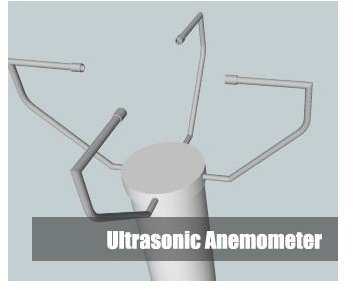
5. Rain Gauges.
- Tipping Bucket Rain Gauge.
This gauge operates using two small buckets on a seesaw board. The rain collection funnel leads into the first bucket and once one hundredth of an inch is collected, the bucket tips the rainwater into a gauge. The funnel is then directed to the second bucket, and the process repeated. The tipping action sends a signal to the weather station that records the number of “tippings”. This is then multiplied by one hundredth of an inch to give the total rainfall over a given period.
The internal parts of a tipping bucket are shown below;

The modern tipping bucket rain gauge is digital but still works on the same principles.
- Weighing Rain Gauge
This is the preferred rain gauge by many meteorologists as it is a very accurate means of rainfall measurement. This is due to the use of a vacuum that allows all the rainwater to enter the funnel and fall into the weighing mechanism and actual gauge. The amount of rainfall is then calculated from the weight. This also allows the amount of rainfall to be recorded by depth (inches) and weight (pounds) over a predetermined timescale.
Summary
There are a number of types of weather instruments located on the grounds of a weather station and used by meteorologists to predict the weather. These include the instruments that have been on the go for over a century with only the manual operation and recording methods being updated to digital and electronic.
The instruments include thermometers, barometers, hygrometers and anemometers as well as a few types of rain gauges that some of us will be familiar with from school days or by having barometers and thermometers in our homes.
Reference Websites:
- Instruments used to gather information. https://www.isws.illinois.edu/atmos/statecli/Instruments/weather_instruments.htm
- Anemometer types: https://www.anemometertypes.com/
This post is part of the series: Weather Forecasting
This series will incorporate several articles on weather forecasting, the instruments used, and the devices such as satellites that carry the instruments and collect weather data from space, atmosphere, and the world’s oceans.
